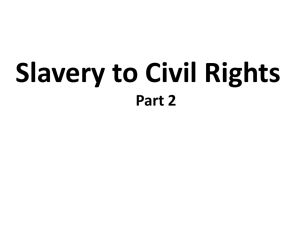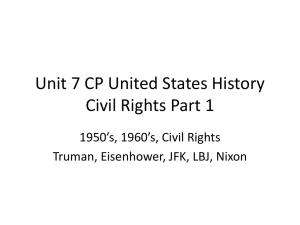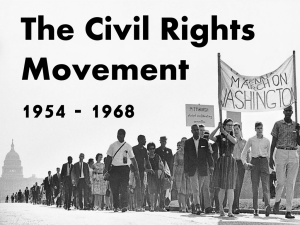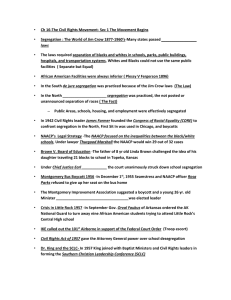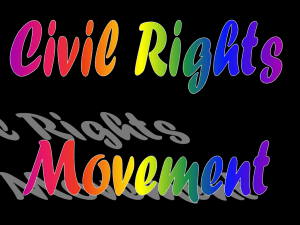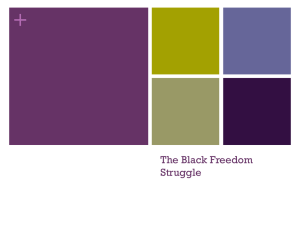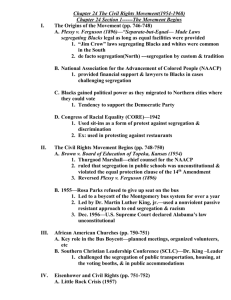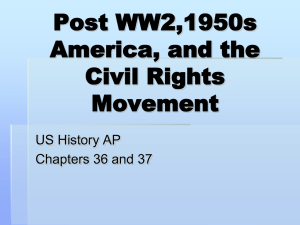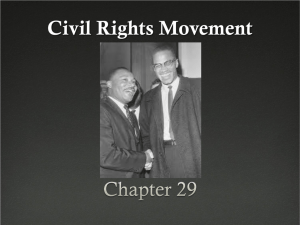Unit 12 Outline
advertisement
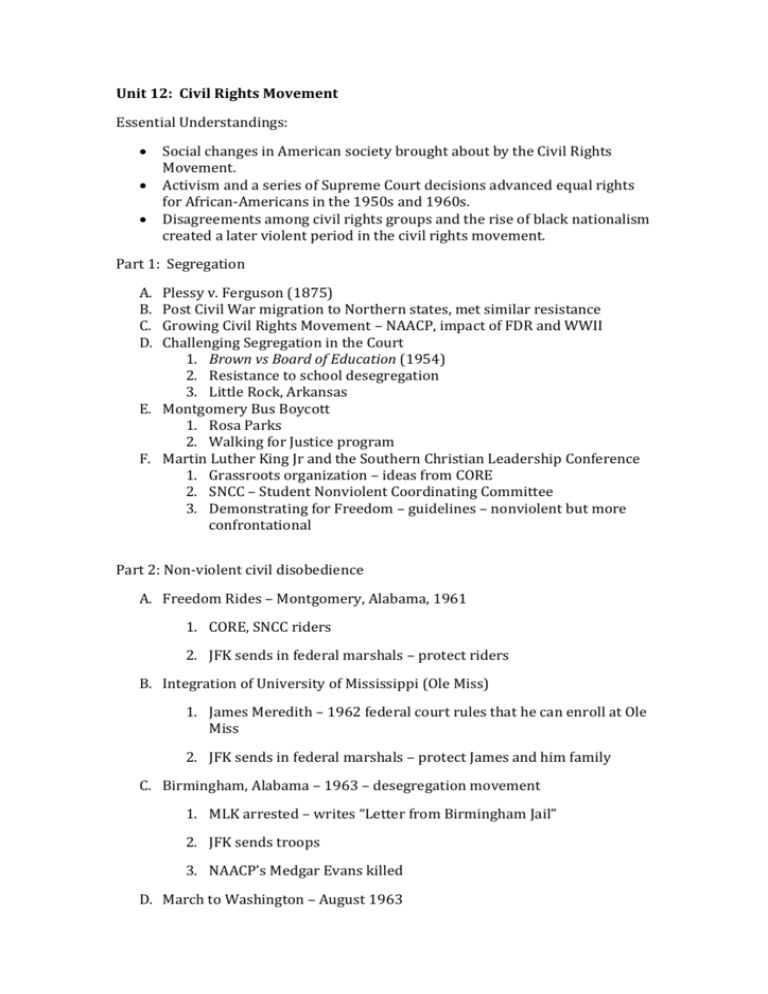
Unit 12: Civil Rights Movement Essential Understandings: Social changes in American society brought about by the Civil Rights Movement. Activism and a series of Supreme Court decisions advanced equal rights for African-Americans in the 1950s and 1960s. Disagreements among civil rights groups and the rise of black nationalism created a later violent period in the civil rights movement. Part 1: Segregation A. B. C. D. Plessy v. Ferguson (1875) Post Civil War migration to Northern states, met similar resistance Growing Civil Rights Movement – NAACP, impact of FDR and WWII Challenging Segregation in the Court 1. Brown vs Board of Education (1954) 2. Resistance to school desegregation 3. Little Rock, Arkansas E. Montgomery Bus Boycott 1. Rosa Parks 2. Walking for Justice program F. Martin Luther King Jr and the Southern Christian Leadership Conference 1. Grassroots organization – ideas from CORE 2. SNCC – Student Nonviolent Coordinating Committee 3. Demonstrating for Freedom – guidelines – nonviolent but more confrontational Part 2: Non-violent civil disobedience A. Freedom Rides – Montgomery, Alabama, 1961 1. CORE, SNCC riders 2. JFK sends in federal marshals – protect riders B. Integration of University of Mississippi (Ole Miss) 1. James Meredith – 1962 federal court rules that he can enroll at Ole Miss 2. JFK sends in federal marshals – protect James and him family C. Birmingham, Alabama – 1963 – desegregation movement 1. MLK arrested – writes “Letter from Birmingham Jail” 2. JFK sends troops 3. NAACP’s Medgar Evans killed D. March to Washington – August 1963 1. Speakers demand passage of Civil Rights bill 2. MLK – “I Have a Dream Speech” E. Civil Rights Act 1964 – signed by LBJ (JFK assassinated Nov 22, 1963) – prohibits discrimination because of race, religion or gender (see pg 920) F. Freedom Summer – 1964 – register blacks to vote in Mississippi G. Selma Campaign – 1965 – voting rights demonstrator is killed, MLK led protest march H. Voting Rights Act 1965 – stops literacy tests, allows federal workers to enroll voters, increases black voter turnout Part 3: Challenges and conflicts within the Movement A. African Americans seek greater social equality 1. Northern segregation – black migration at WWII created “white flight”, most live in poor housing/projects, high unemployment 2. Increased urban violence by the mid-1960s – blacks want equal access to jobs, housing, education 3. National focus begins to turn away from civil rights issues due to increase involvement in Vietnam War B. New Civil Rights Leaders 1. Malcolm X – Nation of Islam (Black Muslims), at first advocates blacks living separately from whites (because they are source of problems) a. Ballots or Bullets speech – upsets whites and moderate blacks b. Pilgrimage to Mecca changes his attitude towards whites, splits with Black Muslims, killed 1965 while giving a speech 2. Black Power – CORE and SNCC become more militant – blacks to control their own lives and communities without white involvement 3. Black Panthers – fight police brutality, violent confrontations, provide social services to ghettos, received popular support in these black communities C. 1968 – Turning Point in Civil Rights 1. Martin Luther King Jr was shot on April 3, 1968 after giving a speech to striking workers in Memphis (dies next day) 2. Reactions to his death 3. Civil Rights Act of 1968 – pg 920 D. Legacy of the Civil Rights Movement 1. Gains: 2. Unfinished work: Key Concepts/Identifications: Brown v Board of Education of Topeka (1954) Rosa Parks Martin Luther King Jr. Southern Christian Leadership Conference (SCLC) Student Nonviolent Coordinating Committee (SNCC) Sit-in Freedom riders James Meredith Civil Rights Act of 1964 Freedom Summer Voting Rights Act of 1965 de facto vs. de jure segregation Malcolm X Nation of Islam Black Power Black Panthers Civil Rights Act of 1968 Affirmative action


